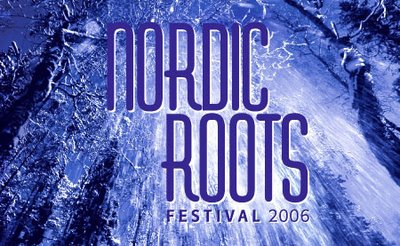
Since it's inception in 1999, the Nordic Roots Festival has lured fans of Scandinavian folk music from all across the country to spend a weekend each year watching world class musicians perform at the Cedar Cultural Center in Minneapolis. This was the sixth of the eight Festivals that I've had the pleasure of attending. A big part of the Festival's enduring appeal is that it has the air of a family gathering; at this point I look forward to seeing a lot of familiar faces, both on the stage and in the audience. The performers also come very eagerly, as they have a hard time finding audiences this receptive to their music even at home. And of course, there is the music. The genre of new Nordic folk music has a lot of original and creative performers putting their own distinctive stamps on a tradition rich in quality music, and all of the best acts have shown up at the Festival at least once over the years.
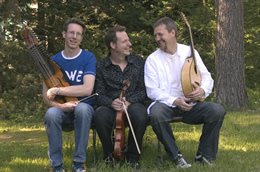
For the first time since 2001, the Festival began on a Thursday night instead of Friday. Performing on Thursday night were frequent Festival headliners Väsen. Simply put, Väsen are one of the planet's great live bands, due to the unmatchable onstage interplay between nyckelharpist Olav Johansson, violist Mikael Marin, and guitarist Roger Tallroth. For this show the trio added a bit of a twist to their usual set by inviting up American fiddler Darol Anger, with whom they've recently been collaborating. Anger brought a quirky, jazzy sound to Väsen's arrangements, adding a few solos above the band's backing. I welcomed the change of pace as a fresh look at a lot of material that is very familiar to me at this point.

Given that there were no shows on Friday afternoon and I had a rental car, Friday was an ideal time to go exploring unfamiliar parts of Minneapolis. My friend Mai and I settled on scenic Minnehaha Park in the southeastern corner of Minneapolis. The beautiful falls inspired Longfellow's "The Song Of Hiawatha," and continue to leave lasting impressions more than a century later.
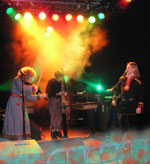
Friday night's concert began with the Festival only first-time performers, Vajas. Vajas are three Sámi from the extreme north of Norway. Like the Finnish Sámi performer Wimme, Vajas combines modern electronics with joiking, a traditional Sámi style of wordless singing. Joiking reminds many people of Native American singing, a connection that does not appear to be lost on Vajas singer Ánde Somby; he composed much of their debut album Sacred Stone in the heat of the Pima Desert in Arizona.
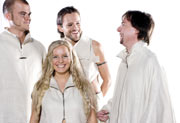
Vajas were followed by Gjallarhorn, from the Swedish-speaking region of Finland. Gjallarhorn's 2000 CD Sjofn is one of the essential albums of the new Nordic folk genre, and one of the best albums of any genre in the present decade. Only singer Jenny Wilhems remains from the Sjofn line-up, but Gjallarhorn still sets Medieval ballads to modern arrangements heavy on percussion and bass droning. The biggest change in their sound comes from the replacement of the Australian digeridoo with a more tonally flexible baroque instrument called the sub-contrabass recorder. It's weird and wonderful both in its look and its sound. Its player, Göran Månsson, jokingly informed the audience that it was available at Ikea in both white and black. Gjallarhorn's set focused on material from their new album Rimfaxe, which focuses on the role of the horse in Nordic mythology. (A legendary horse whose name ends in "faxe"? That sounds awfully familiar, wait don't tell me...) The new material sounded excellent in concert, and Wilhelms is a powerful singer in spite of her diminutive size.

With no guitar workshops to attend this year ( there were a pair each of voice and fiddle workshops, though), I had more time to explore Minneapolis on Saturday afternoon. My girlfriend Donna arrived on Friday night, and she was eager to see the Mall of America. The mall is, well, big. It has an aquarium, a dinosaur exhibit, and at least one indoor amusement park, but we didn't notice anything special or noteworthy from a shopping perspective. Then again, we covered about 5% of the mall in two hours.
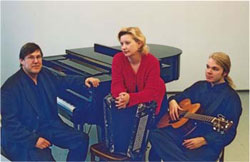
Saturday belonged to the Finnish performers, particularly the outstanding accordionist Maria Kalaniemi. The afternoon set featured Kalaniemi, guitarist Olli Varis, and pianist Timo Alakotila paying tribute to the Finnish tango. Originally from Argentina, the tango was embraced in Finland decades ago, and remains a staple there among both folk and popular musicians. The middle of the floor was left open for dancers, who had a crash course for about half an hour before the show. Kalaniemi's effortless playing makes the accordion sound as graceful as a swan, and her tangos would go over well in any context. She came back in to open the evening concert as a solo artist, occasionally accompanied by Varis, playing pensive, meditative music from her new CD Bellow Poetry. The most striking feature of Kalaniemi's evening set was her newly found willingness to sing. She actually has quite a good voice, but this was the first time I'd heard it. Still, you pay to see Maria Kalaniemi play the accordion, just like you'd pay to see Eric Clapton play the guitar. Anybody who bought the Festival Pass got their money's worth from her twice on Saturday.
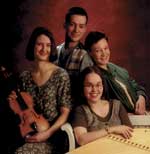
The Saturday evening show was headlined by the Finnish kantele quartet Loituma. Loituma haven't recorded for six years, and haven't really done anything together since 2003. Indeed it seemed doubtful that the band had any future, until something really strange happened. An anonymous blogger posted a little cartoon of an anime character twirling a leek, for no apparent reason, in a repetitive loop. The leek was being twirled to the recording of Loituma's goofy a capella number "Levan Polkka." Somehow, Loituma and the twirling leek made their way across cyberspace, and soon many short films set to "Levan Polkka" could be found online. Interest in Loituma's music soared, and just like that they're playing together again. As they didn't have any new material, their set mirrored what they played when I saw them at the Festival in 2000. This wasn't a bad thing, as I'd forgotten how much I liked them. In addition to being good singers and musicians, they have a good sense of humor and an endearing Finnish charm. Predictably, they closed the main part of their set with their "hit."
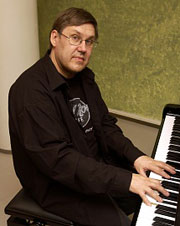
On Sunday morning we visited the Global Market, a quirky mini-mall featuring food and clothing from all sorts of different cultures. It had much more personality in much less space than the Mall of America, if you ask me. And naturally, the lady selling Swedish pastry was going to the Sunday night closing show. In the meantime, Sunday afternoon featured Timo Alakotila performing an off-the-cuff set with a lot of different performers coming up to make guest appearances. Most of the guests were not surprising, given that they were already performing at the Festival. For example, Maria Kalaniemi played some tunes with Alakotila on accordion, as did Swåp's Karen Tweed, who had previously recorded an album with him called May Monday. A few unexpected twists did happen, though, including young fiddle students from the Suzuki program at nearby Augsburg College coming on stage to play a couple of tunes from the repertoire of Alakotila's primary band, JPP.

The final show of the Festival featured two bands who've been part of many of the previous Festivals, and are always received very warmly. Swåp consists of guitarist Ian Carr and accordionist Karen Tweed from England, along with Swedish fiddlers Ola Bäckström and Carina Normansson. They always put on entertaining and energetic shows, and this was no exception. The quartet play off each other terrifically, and like many of the Festival acts, they make the crowd laugh between tunes. Unfortunately, Swåp faces a murky future; Tweed had announced on her website that she'd be leaving Swåp at the end of October to focus on other projects. While she was apparently reconsidering her decision at the time of the Festival, there's no guarantee at present that Swåp will perform at the Festival again in this configuration. This would be a shame, but if true, I can take plenty of solace in the memory of many fine shows over the years.
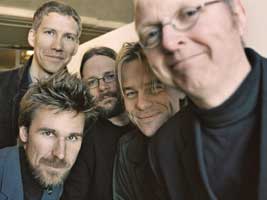
At the 2005 Festival, the Swedish folk/metal party band Hoven Droven put on the kind of show whose legend grows with each retelling, at least among the Festival attendees. The band and the audience fed off each other in a way that I don't think I could do justice describing to anybody that wasn't there. The performance was recorded for posterity, and Hoven Droven's headlining set at this year's Festival coincided with the CD release of that performance, titled Jumping At The Cedar. The band made a brilliantly warped entrance, coming out with banjos and mandolins and singing some country song in English that had really silly lyrics. Then they promptly left the stage, coming back a few minutes later with their usual heavy artillery. The set went over the top at a few points -- perhaps the band tried a little too hard to outdo the previous year's show -- but was wildly entertaining nonetheless. In Hoven Droven's world, traditional polskas can morph into "Manic Depression" by Jimi Hendrix, and nobody thinks twice about it. Given that the Festival was otherwise mellower than normal, the crowd by this point was eager to release some energy, and the band had little difficulty working them into a frenzy. The seats were put away halfway through the set, and the party just picked up steam from there. I guess I'd have to put their 2005 show ahead of this one, as what happened that night was something almost impossible to duplicate, but Hoven Droven certainly left the crowd satisfied again.

As usual, I didn't really want to go home the following morning. But next year's Festival is well into the planning stage, and I'm already counting the days.
Digg This
Del.icio.us




No comments:
Post a Comment